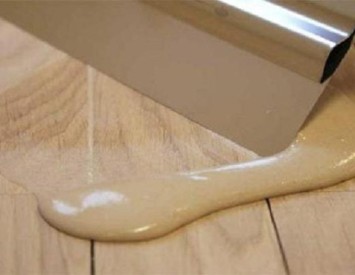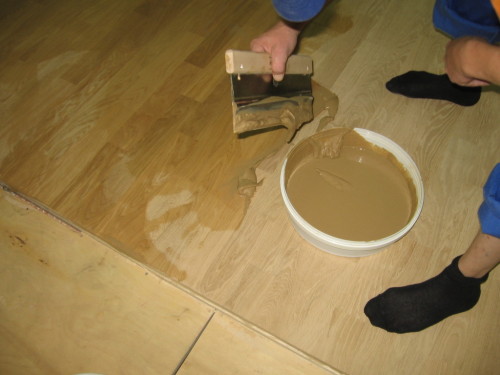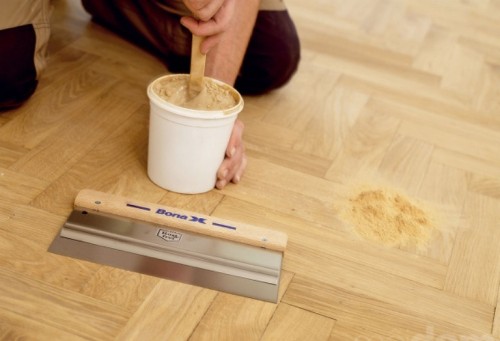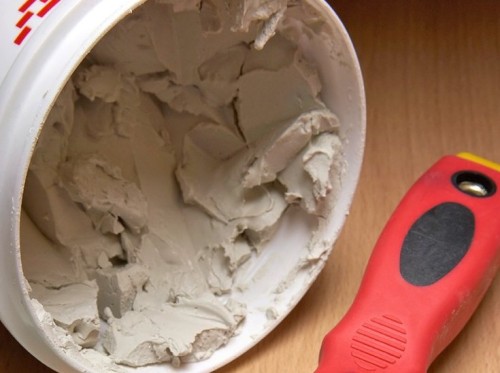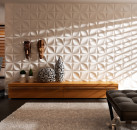Putty is a popular building material used for wall decoration, ceilings and floor. The main task of putty is to eliminate minor defects and level the surface. On sale you can find finishing building material in the form of powder and pasta. Depending on which binders prevail in the composition of putty, several types of material are distinguished.
Content
Types of putty for the floor
To put the wooden floors in order, improve the appearance of the flooring and extend the life, it is necessary to treat the surface with a special putty for a wooden floor.
Types of putty for trim from wood:
- Acrylic.
- Oil.
- Polymer.
- Based on the solvent.
Acrylic putty copes well with the elimination of minor defects, and also fills the seams. The peculiarity of this type of putty is that it is considered harmless and resistant to moisture. In addition, acrylic putty is plastic, it is easy to work with it. The main requirement that must be fulfilled when working with this material is to carefully prepare the surface. The wooden floor should be clean and dry. After the putty is completely dried, the surface will be smooth and shiny.
The qualities of acrylic putty:
- removes different defects of the wooden coating;
- grinding joints;
- regardless of temperature - does not emit toxins and does not evaporate;
- harmless;
- elastic, soft material;
- high resistance to fire.
Oil putty consists of chalk, oil and water. The mixture has one significant drawback - a long period is required to wait for the complete hardening of the mixture. If you do not pay attention to this nuance, then in general an oil -based putty is a practical and strong material that will last for many years.
To process the wooden floor, you can use polymer putty on wood. It consists of water and polymeric materials. The main purpose of polymer putty is to fill in the cracks, level irregularities, eliminate defects in wooden floors. Polymer putty has one significant plus - prevents the accumulation of dust and does not allow the processed edges of the tree to be clogged. The putty dries very quickly, and the gap filled with putty, even after several years of operation, will not sag and fail.
Advantages of polymer putty:
- fills the cracks;
- freezes quickly;
- environmentally friendly material.
When working with polymer putty, it is necessary to adhere to such restrictions: do not process floors from cork wood, do not apply the mixture directly to the floorboards.
The composition of putty based on the solvent includes wood dust. Material is treated with a parquet floor and wooden surfaces. Such putty can be used to process wooden surfaces equipped with a “warm floor” system. The main advantage of this finishing material is the ability to process different wood species, even exotic. The putty is unpretentious in work, it is easy to apply, and it dries very quickly.
When you need to use the putty for the floor
The putty on the floor for the floor will be needed if the new gender is laid, including the parquet. It is also often necessary to process the wooden floor surface during cosmetic repair, when it is necessary to update the coating.
If it is decided to lay a wooden coating on the floor, then you can’t do without putty. She will fill all the seams and irregularities - the floor will be smooth and even. They also use putty in the cosmetic repair of wooden floors. Before painting, it is necessary to fill all cracks with putty and smooth the irregularities. As a result, when processing wooden floors with putty, the life of the natural coating increases significantly.
How to make putty yourself
In a construction store you can buy any putty, but when it is not possible to purchase it, you can independently make a mixture for the restoration of a wooden floor.
The basis of putty is Olifa. For 500 g of olifa, you need to prepare the following components:
- animal glue (10%) - 100 g;
- turpentine or kerosene based on varnish - 125 g;
- liquid sequettas - 25 g.
Also, to prepare putty, you will need a dry sifted chalk - 0.5 kg and a liquid soap of 100 g.
The technology for preparing a putty mixture should be strictly observed:
- First you need to heat animal fat on fire, constantly stirring to insert liquid soap into the mixture.
- In small portions, the components in this sequentially are introduced into the mixture: Olifa, turpentine and sequacule. The mixture is mixed.
- The hot mixture can be removed from the heat, add chalk and mix. By consistency, putty should resemble store sour cream.
Using independently prepared putty, it must be remembered that the mixture should always remain warm. If it is necessary to fill in a few cracks and smooth the irregularities, then do not cook a large amount of putty. During work, even if a large area is processed, the material must be maintained in a warm state, so prepare a pelvis or a bucket of hot water in advance and place a bucket with putty in it.
You can cook putty for processing wooden floors using the minimum amount of materials. The budget recipe for preparing the composition for the sealing of cracks consists of a mixture of PVA glue and sifted chalk. The putty should resemble thick sour cream by consistency. If it is necessary to eliminate significant defects in the wooden floor, then crushed dry wooden sawdusts are added to the mixture. Such a putty dries for about 2 days.
Important: when using wooden sawdust, they must first be soaked for 24 hours in warm water or in a liquid that will be used to make putty.
Another simple recipe for making putty at home: take chalk or cheap finish plaster, dilute a dry mixture with water -soluble or acrylic varnish. Mix the mixture to a pasty state.
If it is necessary to treat wooden floors in a wet room, then it is better to use an oil base putty. It consists of 1 kg of olifa, 100 Siccective of the NF-1 brand and 2 kg of mela.
Putting from construction waste: Take a pure oil -base linoleum (without insulation), break it into pieces and pour acetone. Wait for the putty to acquire the desired consistency.
Important: when working with chemical fluids, it is necessary to use protection products. It is better to prepare the mixture in a well -ventilated room or in the fresh air.
Concrete flooring
To cover the concrete floors, self -leveling cement plastic putty is used.
The stores represent such types of finished putty:
- acrylic;
- polyester;
- on a water -based.
Self -leveling putty is used for continuous puttying of floors. This material is highly elastic. The putty “Thomsit DD” received good reviews, it fits with a thickness of not more than 5 mm, quickly hardens, is suitable for processing a large area, strong and durable.
Polyeshir putty for concrete floors is also popular. It has high strength, elastic. The main advantage of polyester putty is that it does not shrink after drying, but when working with this material, putty layer cannot be applied. It is better to first apply 1 thin layer, wait for complete drying, and then put another 1 layer of putty.
20 years ago, when aligning the floors, a concrete mixture was used. It is prepared from 1 part of cement and 3 parts of sifted river sand. Both components are mixed, the water is poured into the mixture gradually (0.5 liters of water are taken per 1 kg of cement). The solution should not be very liquid and not spread. The floor screed is used.
To get a good result, it is necessary to allocate 1 day on the screed and after applying the solution to wait for complete drying. According to the rules, a drying screed must be watered every day with water, and then covered with polyethylene. The concrete screed will gain strength after 28 days, and after leveling the surface on the concrete floor, you can lay any coating.
When choosing a putty for the floor, it is important to consider such requirements as the time allotted for drying the composition and humidity of the room. There are types of putty, which are used only at a certain temperature with a low level of humidity. These nuances must be taken into account. It is also necessary to wait for the complete drying of the putty (about 24 hours) and minimize the load on the processed surface.
